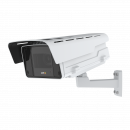
Burden on medical staff reduced via remote monitoring of medical devices.
Axis solution implemented in artificial dialysis machine room helps create 24-hour surveillance system.
Mission
Motomura Clinic for Internal Medicine is located in Oonojyou-shi, Fukuoka Prefecture, near Fukuoka-shi. The clinic is a lifeline to more than seventy patients who need artificial dialysis, and the artificial dialysis devices in the clinic operate every day without ceasing. The inside of the facility is divided into a dialysis room where patients undergo artificial dialysis and a machine room for creating dialysate, and generally the machine room is centered around four machines. Every day these machines are cleaned and sterilized automatically during the night in preparation for next day’s dialysis. Therefore, if an alarm goes off during nighttime operation, it is necessary for medical staff to inspect and deal with the cause of the alarm even during the night.
Up till this time at the clinic, a notification system using a telephone line was employed, but with this system it was not possible to know detailed content of alarms, and it was necessary to find out specific alarm content after arriving at the machine room. “To quickly obtain information on specific content of alarms and respond correctly,” – this was the challenge.
Solution
Chief Engineer Kiyohumi Takatori, a clinical engineer who manages the artificial dialysis machines, thought about ways to solve this challenge using videos for over ten years. He had the idea to photograph the monitors which the machines are equipped with using a video camera. However, the four machines are placed apart from one another in the room and cannot easily be moved. A camera that could accurately photograph the monitors of the four machines installed in different places was required.
In 2010, a system using the AXIS P5534 PTZ Network Camera was proposed as a solution. Sensors were set up on the four machines and connected to an input/output port of the camera. When a signal is sent to the camera from a machine which has issued an alarm, the camera changes position to a direction set in advance, and sends an video of the monitor screen to a mobile phone or smartphone by email. In the video attached to the email, details are clearly shown, right up to small characters on the monitor, so it has become possible to accurately grasp the content of alarms issued.
It was necessary to obtain information about alarms issued by the machines quickly and deal with them correctly. We must not keep patients waiting.
Result
After the implementation of the AXIS P5534 PTZ Network Camera, the following results were gained:
- All the clinical engineers and medical device management providers can grasp content of alarms issued instantly, so action as a team without undue burden on particular staff members is now possible
- By checking videos, communication with managers in the clinic can be conducted and decisions and directions regarding operations, parts replacement, and the like can be made based on accurate information, and therefore it has become possible to reduce the delay in decisions caused by difference in experience
“We must not keep patients waiting,” says Mr. Takatori. Through being able to respond properly to nighttime alarms, a virtuous circle has been produced whereby the psychological pressure felt by medical staff has been eased and human error has been reduced, and along with that, patients can receive treatment with peace of mind.
PTZ function and data input/output are essential
The four machines necessary for artificial dialysis are placed in a U-shape, and each machine’s monitor is facing a different direction. In order to photograph the differently facing monitors, a camera with a pan/tilt/zoom function and also a function for receiving data sent from sensors of the machines was necessary.
The AXIS P5534 PTZ Network Camera has four data input/output ports, and can register a maximum of 100 positions. In this example, the positions of the camera in which the monitors of each machine were captured were registered as four positions. The camera identifies the signal sent from the sensor inside a machine and changes position to photograph its monitor.

Need for capturing small monitor screens on camera
The monitors installed on each machine are small, at about 5-8 inches. The camera is installed on the ceiling, and in order to accurately capture the small monitors on video, a camera with high-resolution and a highpowered lens is necessary. Moreover, because the lights are put out in the machine room at night, it is necessary to be able to photograph even with the luminous intensity of the monitor backlight. AXIS P5534 PTZ has HDTV 720p resolution and an 18x optical zoom, and can photograph using a low luminous intensity, as low as 0.04 lux. In this case, it was possible to achieve color images with just the luminous intensity of the monitor backlight with no problem at all.
Preventing human error with network cameras
“We cannot completely eliminate human error, but it is possible to prevent it from occurring. We introduced a camera in order to fully understand machine room alarms, but we are also conducting trials in which the AXIS M10 series is used to give directions to medical staff accurately. Being in a position where people’s lives are in our hands, we would like to be able to continue to utilize network cameras in the future,” said Chief Engineer Kiyohumi Takatori, clinical engineer.
Products & solutions

Healthcare
Get in touch
Want to know how you can benefit from Axis solutions? Get in touch and we will help you.
Contact us
